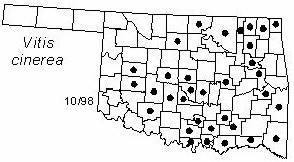Woody vine climbing to 10 m (33 ft) or higher. Branches tomentose with ashy-white or gray hairs, young branches angled. Tendrils branched. Leaves suborbicular to broadly ovate, 10-20 cm (3.9-7.9 in) long and as wide or wider, irregularly and coarsely toothed, usually unlobed or with 2 very short side-lobes but sometimes deeply 3- or 5-lobed, floccose above when young but becoming glabrate, usually cobweb-hairy below. Inflorescence a dense compound panicle 6-15 cm (2.4-6 in) long, flowering in late Spring. Fruits black or purple, 4-9 mm (0.2-0.4 in) in diameter, ripening in Fall.
Distribution: Native to about the southeastern third of the U. S..
Habitat: Floodplain forests, streambanks, fencerows.
NWI status: none
Comment:The fruits vary widely in taste and juice content, but are often used to make wild grape jelly. Many species of wildlife eat the fruits. Vitis is the old Latin name for grape; cinerea refers to the pale gray appearance of the twigs and young leaves.
Distribution in Oklahoma: 
BACK
NEXT
RETURN TO INDEX
Last update: 9/22/99
 Go to Oklahoma Biological Survey Home Page
Go to Oklahoma Biological Survey Home Page
 Disclaimer
Disclaimer